The Lambdas in Testing and Where They Should Head to in 2025 – A Vision [Testμ 2023]
LambdaTest
Posted On: August 22, 2023
![]() 3572 Views
3572 Views
![]() 10 Min Read
10 Min Read
Lambda, as the term implies, signifies a wave-like progression. In the testing realm, it encapsulates the notion that we must embrace concise feedback loops for expeditious releases. Over the past decade, these loops have been drastically shortened, transitioning from monthly releases to daily ones and even multiple times a day.
To explain what are lambdas in testing and where they should head in 2025, Pradeep Soundararajan, Founder and CEO of Bugasura and Moolya, shares his views in this keynote session and how one can figure out the way to re-simplify testing.
If you couldn’t catch all the sessions live, don’t worry! You can access the recordings at your convenience by visiting the LambdaTest YouTube Channel.
What are Occupational Hazards for People in Tests?
Pradeep kicked off the session by focusing on occupational hazards for testers.
According to Pradeep – the actual occupational hazard for testers is testing itself when it becomes their sole occupation. It’s when testing is confined only to their professional role and doesn’t extend beyond that.
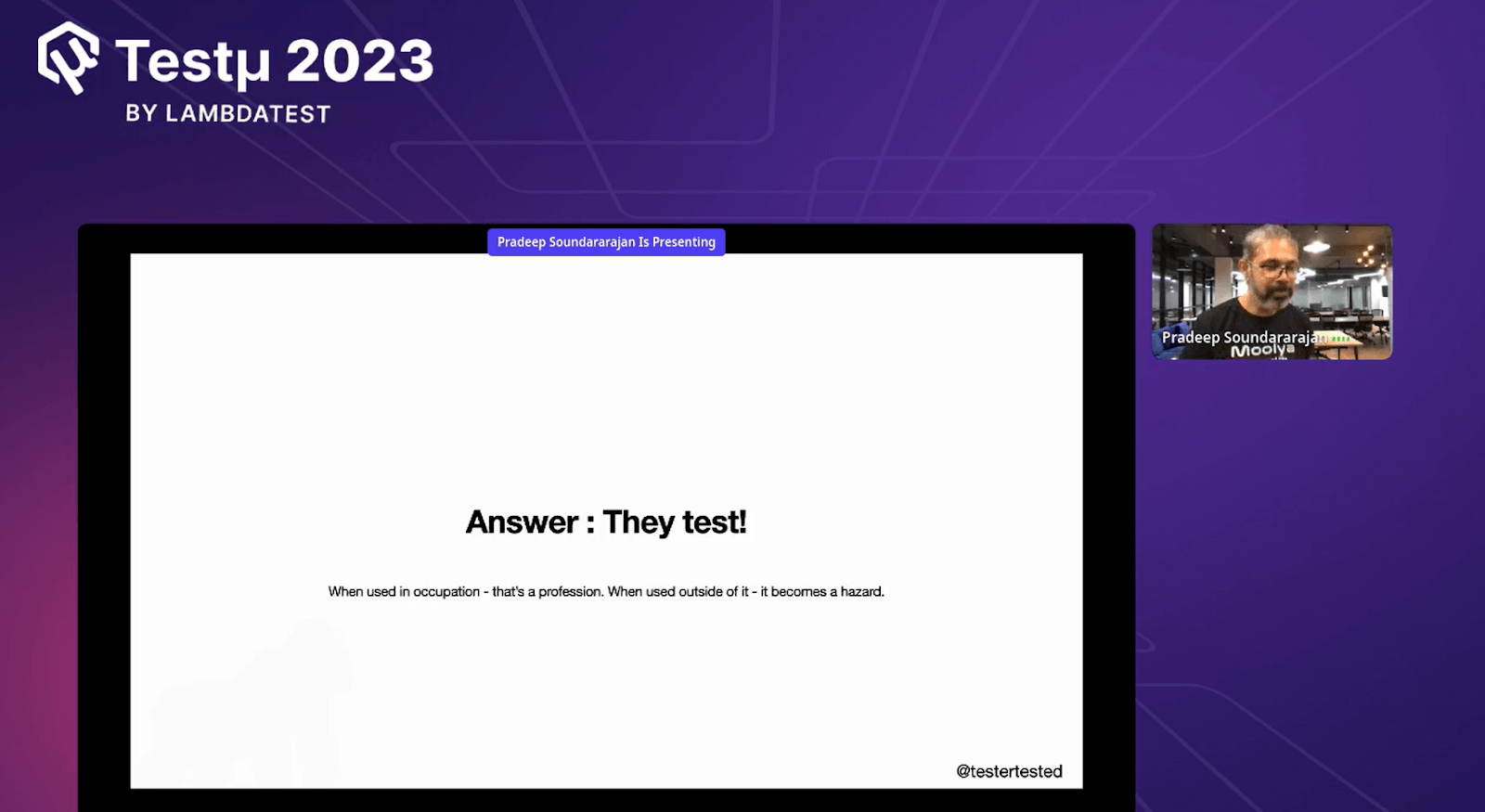
He points out that testing can become a specialized profession with its own difficulties, and using testing skills outside of work can have drawbacks. He acknowledges the attendees’ critical thinking abilities, which are valuable in their profession but warns against overusing them outside of work, as it can impede learning. He encourages participants to engage actively in the testing conference, where they can balance their testing expertise with the pursuit of new knowledge.
Pradeep goes on to discuss the concept of testing as a widespread activity, not just limited to individuals with titles related to testing. He uses the example of CEOs like himself, who constantly test new pitches when presenting ideas to various stakeholders. This extends to other C-level executives: CMOs test ad campaigns, CTOs evaluate technological architectures, CPOs test customer hypotheses, COOs gauge organizational efficiency, and CIOs assess value delivery.
Everyone in the business; is in the business of testing – @testertested 🙌
He believes everyone is in the business, and testing is a great way of learning, as learning leads to action and helps in decision-making, which assists in business growth. 🚀 pic.twitter.com/oyFIGXwLez— LambdaTest (@lambdatesting) August 22, 2023
He emphasizes that everyone, from CXOs to those in various business roles, is testing something to benefit customers and decision-making. Pradeep highlights that testing is a fundamental aspect of business and decision-making that goes beyond the traditional confines of software testing. He wants the audience to realize that their critical thinking and testing skills are valuable within their professional roles and as a broader mindset applicable throughout the business landscape.
Why is Everyone Doing Some or the Other Test?
Pradeep raises a pertinent question: “Why is everyone doing some or the other test?” He wonders why organizations don’t simply entrust testing tasks to dedicated testing teams for feedback. He expresses confidence in testers’ willingness to engage but questions how much CXOs are involved in testing processes.
Testing as a Path to Learning
Pradeep’s reasoning revolves around the fundamental concept that testing is a reliable method for acquiring knowledge. This principle, he notes, predates software testing and has been employed as a means of learning throughout history. He probes further, questioning why individuals, particularly CXOs, are so driven to learn. Pradeep asserts that learning is a catalyst for effective action. Without continuous learning, decisions made by individuals, especially those at the highest organizational levels, would lack utility for customers and business growth.
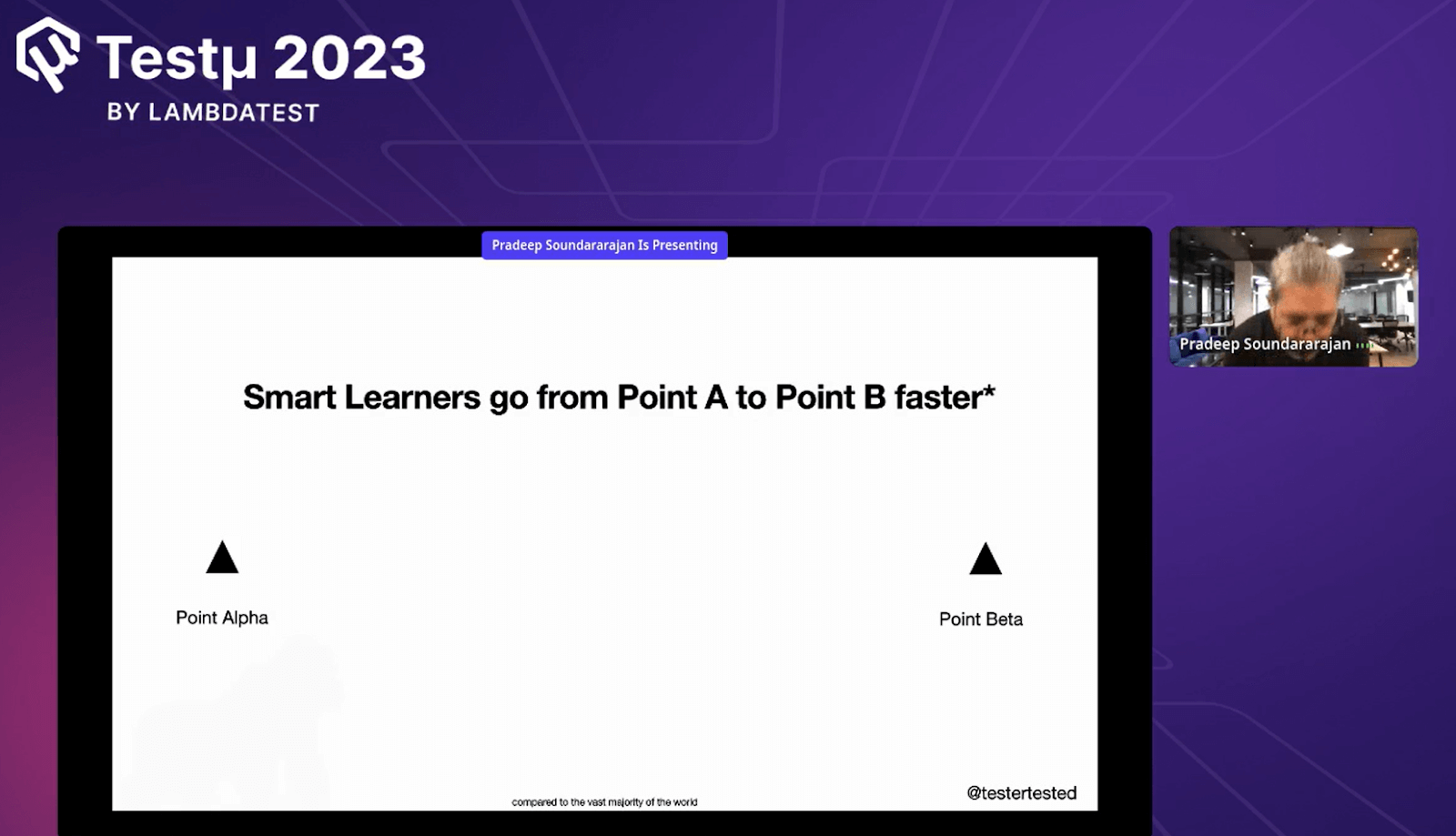
He delves into the iterative learning process, emphasizing that the journey from point A to point B is rarely linear or straightforward. He visualizes this as a non-linear trajectory, illustrating that progress is marked by hurdles even with highly skilled individuals. The uncertainty lies in not fully grasping the destination (point B) and constantly striving to identify the most efficient route. The central driver of progress is iteration, rapid testing, and speedy learning. Pradeep highlights the importance of reducing the time between iterations, given the rapidly changing market dynamics.
The Need for Speed in Testing
Pradeep initiated a poll, “Is speed everything in testing?” to engage the audience and elicit diverse viewpoints. This query invites reflection on the balance between rapid testing and comprehensive, reliable outcomes. The underlying message is that while speed is vital, it’s not the sole determinant of successful testing.
He also underscores a crucial point: speed in the wrong direction can lead to disastrous outcomes. He asks the audience questions, inquiring about instances when they witnessed this phenomenon in their projects. Pradeep describes a scenario where individuals endeavor to reach point B (as discussed above) while navigating a wrong path. He cites examples of projects that progressed quickly but ultimately faltered due to a misguided emphasis on speed without a clear sense of direction.
Pradeep, using one of the memes humorously, depicts how some front-end automation projects seem successful initially, showcasing advancements from point A to point B. However, upon closer inspection, these projects encounter challenges such as failing tests and increased maintenance demands.
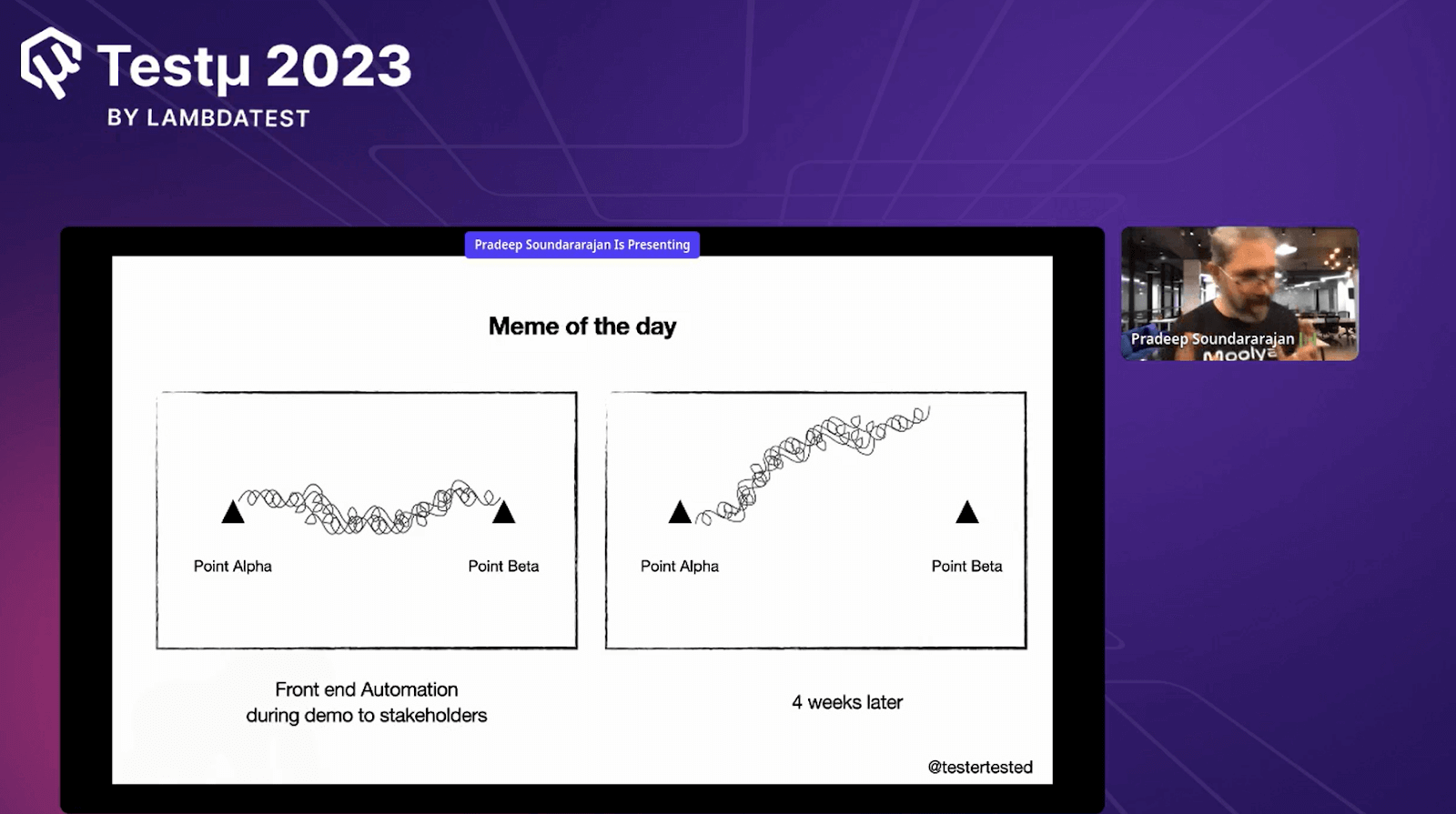
Entropy, Culture Shifts, and the Role of CTOs
Pradeep delves into the concept of entropy in testing, where the lack of certain practices generates more job opportunities within the testing field. He explores the notion of “shift left,” emphasizing the importance of changing engineering cultures to incorporate robust testing practices. He praises the role of CTOs in fostering a programmatic approach to testing, enhancing collaboration and alignment between development and testing.
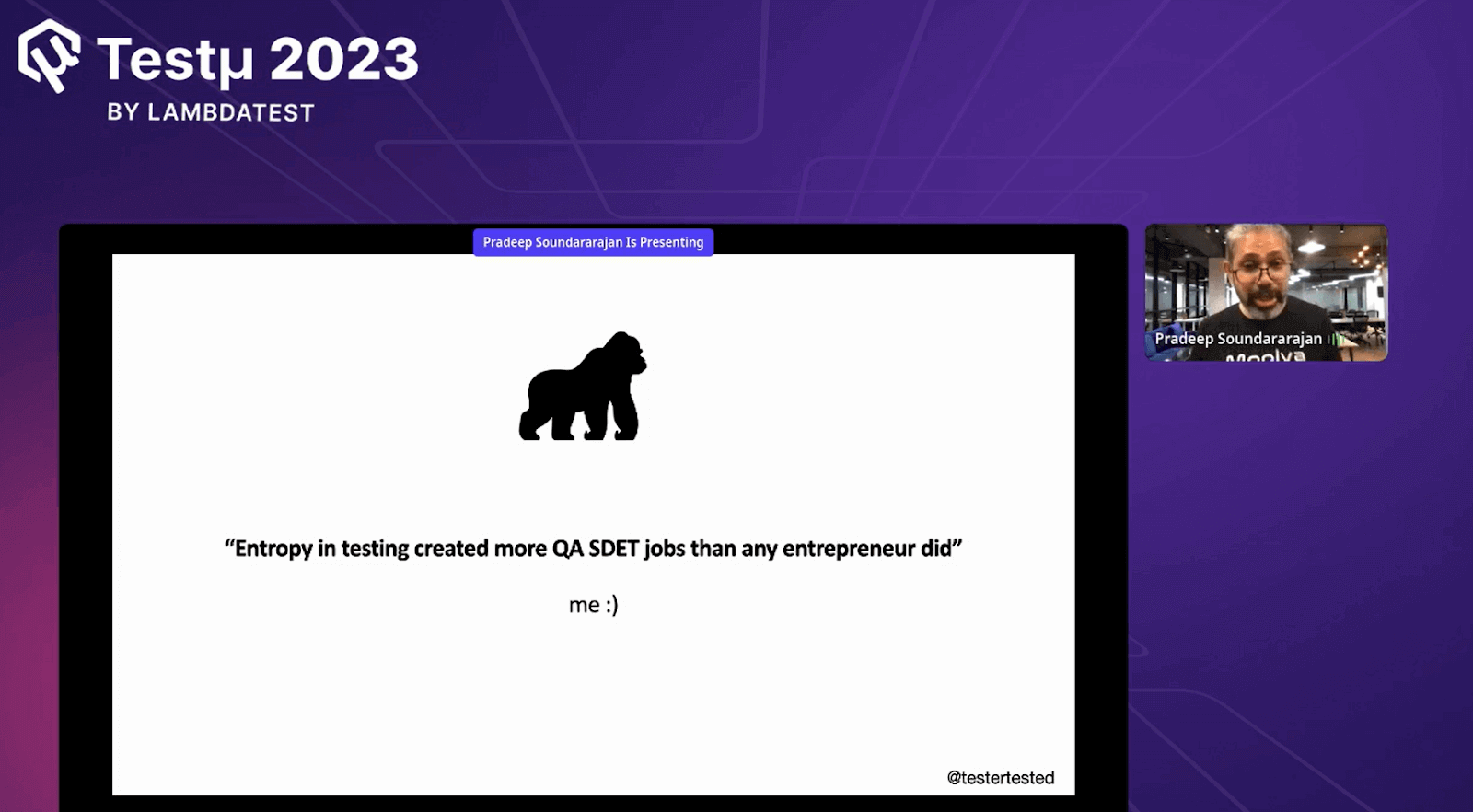
He hails the role of CTOs in shaping the industry’s testing landscape, leading to shorter feedback cycles. He lauds their contribution in transforming testing into a dynamic and efficient process. This transformation is a response to the evolving industry, shifting from waterfall methodologies to sprint-based approaches. Pradeep credits the CTOs for their instrumental role in catalyzing these shifts and expediting feedback loops.
Pradeep highlights the remarkable surge of innovation and automation in the testing domain over the past decade. He talks about the proliferation of tools, technologies, and frameworks that have amplified testing efficiency and speed. The industry has witnessed the emergence of tools for various purposes, from infrastructure management to learning automation.
He delves into the reasons behind the drive for continuous improvement and explores the concept of testing’s evolution. Drawing parallels with Mount Everest’s changing landscape, he compares how technological advancements have propelled testing forward.
ChatGPT Impact on Stack Overflow
Pradeep discusses the impact of ChatGPT on Stack Overflow’s functionality. He credits ChatGPT for curbing the overflow of repetitive questions, showcasing an efficiency peak. Pradeep highlights the convenience of readily available automation scripts and tools and points out that the present level of convenience is remarkable. He addresses the aspiration for greater efficiency and automation in testing.
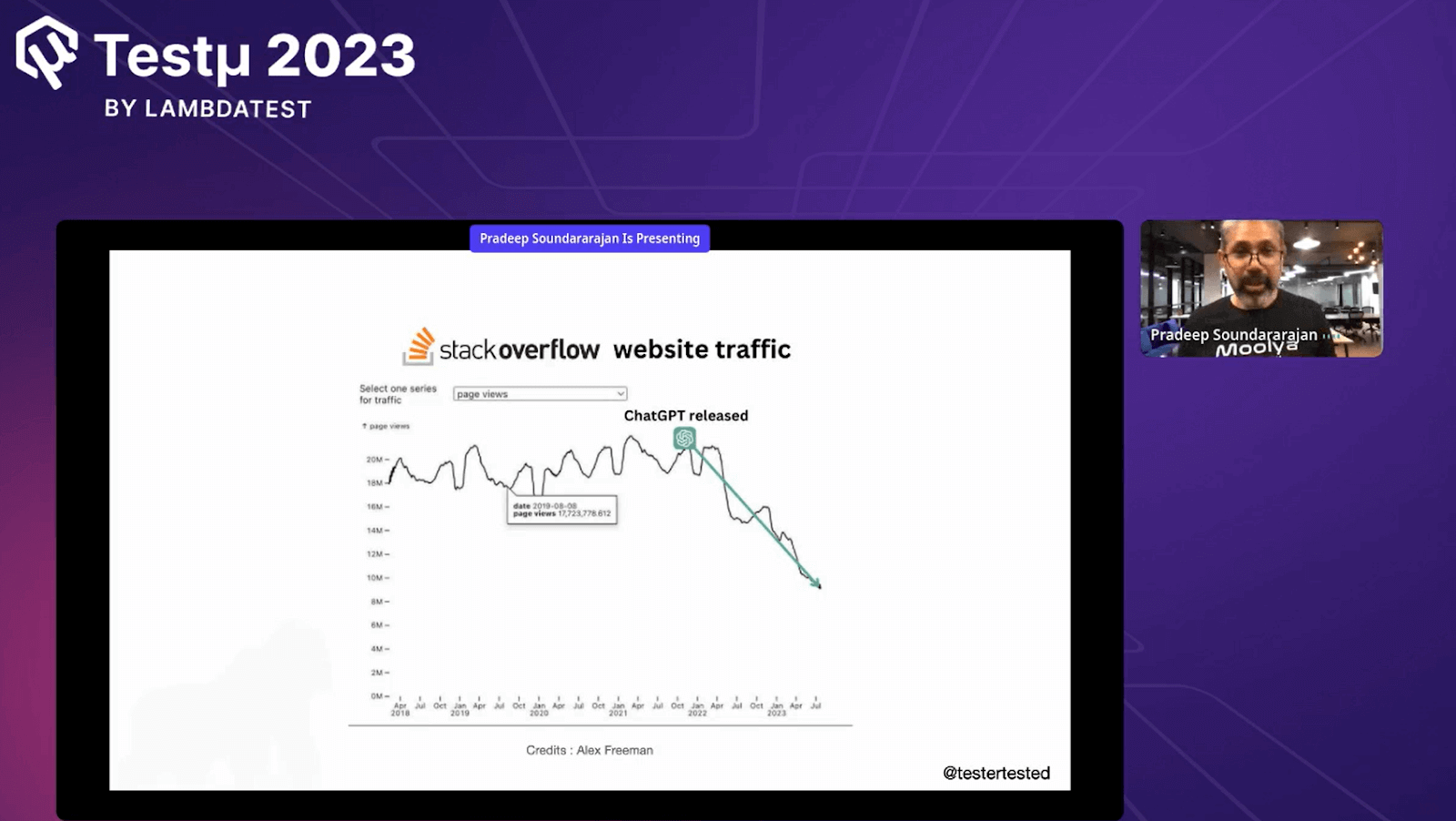
The Challenge of Gen AI in Testing
Pradeep introduces the challenge of using generative AI (Gen AI) in testing. He poses a question to the audience, inquiring about the issue they perceive with Gen AI in testing. Pradeep uses this interactive approach to initiate a discussion on the limitations of Gen AI. He puts forth his own perspective on the challenge, which revolves around the quality and suitability of training data. He presses upon the quality of training data that directly impacts AI’s effectiveness in testing. He emphasizes that the industry often needs to feed more training data to AI tools, limiting their potential.
Sharing the vision for 2025, Pradeep talks about embracing excellence in test automation, especially with the rise of transformative technologies like generative AI, as it will become the new frontier of it working with humans. pic.twitter.com/t9LBOpfE3e
— LambdaTest (@lambdatesting) August 22, 2023
He advocates for a shift in mindset when utilizing AI in testing. Rather than focusing solely on script healing, he suggests asking whether a script is still helpful and relevant. He encourages adopting a proactive approach involving analyzing utility and necessity tests. Pradeep notes a disparity between developer and testing tools, suggesting a need for more innovation in testing.
The Vision for 2025
Pradeep envisions the adoption of AI to prevent bugs rather than simply discovering them. He envisions a future where AI suggests potential bug risks during architectural design, helps build unit tests and aids in code refactoring. Pradeep imagines a symbiotic relationship between humans and AI, focusing on innovation and value creation. He emphasizes expanding testing’s horizons beyond its conventional roles.
Pradeep outlines the importance of analytics-driven testing and AI to build tests based on usage and customer data. He highlights the significance of preventing bugs through intelligent measures. Pradeep envisions testers working in tandem with AI to enhance the quality and value of testing. He urges testers to overcome the efficiency trap and embrace the evolving testing landscape.
Time for Q&A Session!
- How do you find our North Star in enterprise product testing?
- How to learn a new tech faster?
- Looking back a decade ago, things are very different from what we have today. So, if we’re starting very new into testing, given the advent of all these fancy tools we have right now to make things lazy, what would be some of your advice and tips to get started in testing?
Pradeep: In enterprise product testing, identifying the North Star involves recognizing the challenge of maintaining innovation within an established framework. Unlike startups still seeking their direction, enterprises have achieved market presence but face sustaining growth beyond a tipping point.
The focus should be on how rapidly innovation is embraced, as many enterprises excel in consistency but struggle with fostering innovation due to restrictive environments. To address this, enterprises often establish startup incubators to promote internal innovation. If you’re part of an enterprise, collaborating with such initiatives can guide your path toward innovation. This pursuit of innovation represents the North Star for enterprise product testing.
Pradeep: To accelerate the process of learning a new technology, it’s crucial to establish a solid foundation. Without a strong grasp of fundamental concepts, mastering any new subject can be challenging. Begin by reinforcing your fundamental understanding of related protocols and principles. Once your base knowledge is solid, approach the new technology by identifying its underlying protocol layers.
By dissecting these layers, you can systematically comprehend the new technology’s structure and functionality. Remember, if you’re struggling to learn, revisiting and strengthening your foundational knowledge will be a springboard for more effortlessly grasping new concepts.
Pradeep: Over the past decade, learning resources have become abundant, and a supportive community of mentors has emerged to help people succeed. Unlike two decades ago, when finding dedicated mentors was challenging, today’s learners have access to resources and people eager to guide them. This positive change is thanks to individuals like you who contribute to the community, fostering a collaborative learning environment.
In case you have more questions, please feel free to drop them at the LambdaTest Community.
Got Questions? Drop them on LambdaTest Community. Visit now













